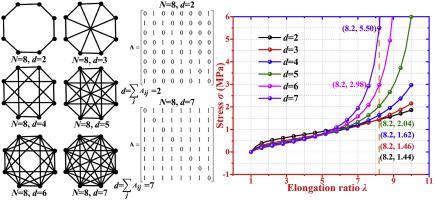Polymer ( IF 4.1 ) Pub Date : 2022-11-18 , DOI: 10.1016/j.polymer.2022.125531 Ziyu Xing , Dong-Wei Shu , Haibao Lu , Yong-Qing Fu

|
Molecular network plays a critical role in determining dynamic elasticity of soft condensed polymers, e.g., their varied cross-linking densities and end-to-end distances with changed Young's moduli. Although it has been studied for decades, the coupling relationship between vertices and edges of molecular networks is not well understood, mainly because the degree of the crosslinking points and asymmetry molecular networks have not been considered in the previously models. In this study, a graph theory was employed to formulate an undirected graphical model and describe the coupling between vertices and edges in molecular networks, based on which the dynamic elasticity of polyelectrolyte hydrogel was modeled. From the Kirchhoff graph theory and bead-spring model, the coupling relationship between vertices and edges was obtained using end-to-end distance and viscosity parameters. Combining the Watts–Strogatz model and kinetic probability, the coupling between vertices and edges for the polyelectrolyte network was studied. Furthermore, an adjacency matrix with eigenvalue, number of vertices and mean degree was proposed to formulate constitutive relationships including dynamic elasticity and stress-strain, according to rubber elasticity theory and Mooney-Rivlin model, respectively. The linking between the vertices and edges determines the network structure and dynamic elasticity of the polyelectrolyte hydrogel. Based on the graph theory, the vertices and edges are encoded by adjacency matrix, which is proposed to describe the dynamic elasticity of symmetric and asymmetric network structures using the crosslinking density and end-to-end distance. Finally, effectiveness of the undirected graphical model was verified using both finite element analysis and experimental results of polyelectrolyte hydrogels reported in literature.
中文翻译:

聚电解质水凝胶动态弹性邻接矩阵的无向图模型
分子网络在确定软凝聚聚合物的动态弹性方面起着关键作用,例如,它们随着杨氏模量的变化而变化的交联密度和端到端距离。尽管已经研究了几十年,但分子网络的顶点和边缘之间的耦合关系并没有得到很好的理解,这主要是因为在以前的模型中没有考虑交联点的程度和分子网络的不对称性。在这项研究中,图论被用来制定一个无向图模型并描述分子网络中顶点和边缘之间的耦合,在此基础上对聚电解质水凝胶的动态弹性进行建模。从基尔霍夫图论和珠弹簧模型,使用端到端距离和粘度参数获得顶点和边缘之间的耦合关系。结合 Watts-Strogatz 模型和动力学概率,研究了聚电解质网络的顶点和边缘之间的耦合。此外,根据橡胶弹性理论和 Mooney-Rivlin 模型,分别提出了具有特征值、顶点数和平均度数的邻接矩阵来制定包括动态弹性和应力-应变的本构关系。顶点和边缘之间的连接决定了聚电解质水凝胶的网络结构和动态弹性。基于图论,顶点和边由邻接矩阵编码,建议使用交联密度和端到端距离来描述对称和不对称网络结构的动态弹性。最后,使用文献中报道的聚电解质水凝胶的有限元分析和实验结果验证了无向图模型的有效性。











































 京公网安备 11010802027423号
京公网安备 11010802027423号